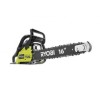Ryobi RY3716 Operation Manual - Page 22
Warning, Removing Buttress Roots
 |
View all Ryobi RY3716 manuals
Add to My Manuals
Save this manual to your list of manuals |
Page 22 highlights
OPERATION the lower cut of the notch before the upper cut. See Figure 21. Felling Backcut. The backcut is always made level and horizontal, and at a minimum of 2 in. above the horizontal cut of the notch. See Figures 21 - 22. Never cut through to the notch. Always leave a band of wood between the notch and backcut (approximately 2 in. or 1/10 the diameter of the tree). This is called "hinge" or "hingewood." It controls the fall of the tree and prevents slipping or twisting or shoot-back of the tree off the stump. See Figures 21 - 22. On large diameter trees, stop the back cut before it is deep enough for the tree to either fall or settle back on the stump. Then insert soft wooden or plastic wedges into the cut so they do not touch the chain. The wedges can be driven in, little by little, to help jack the tree over. See Figure 23. NOTE: When bucking or felling with a wedge, it may be necessary to remove the SAFE-T-TIP™ anti-kickback nose guard to allow the bar to be drawn through the cut. After the cut is complete, the tip should be reinstalled immediately. As tree starts to fall, stop the chain saw and put it down immediately. Retreat along the cleared path, but watch the action in case something falls your way. Be alert for overhead limbs or branches that may fall and watch your footing. WARNING: Never cut through to the notch when making a backcut. The hinge controls the fall of the tree, this is the section of wood between the notch and backcut. REMOVING BUTTRESS ROOTS See Figure 24. A buttress root is a large root extending from the trunk of the tree above the ground. Remove large buttress roots prior to felling. Make the horizontal cut into the buttress first, followed by the vertical cut. Remove the resulting loose section from the work area. Follow the correct tree felling procedure as stated in Felling Trees after you have removed the large buttress roots. KICKBACK Page 22 - English VERTICAL CUT LOOSE SECTION HORIZONTAL CUT Fig. 24 Fig. 25















